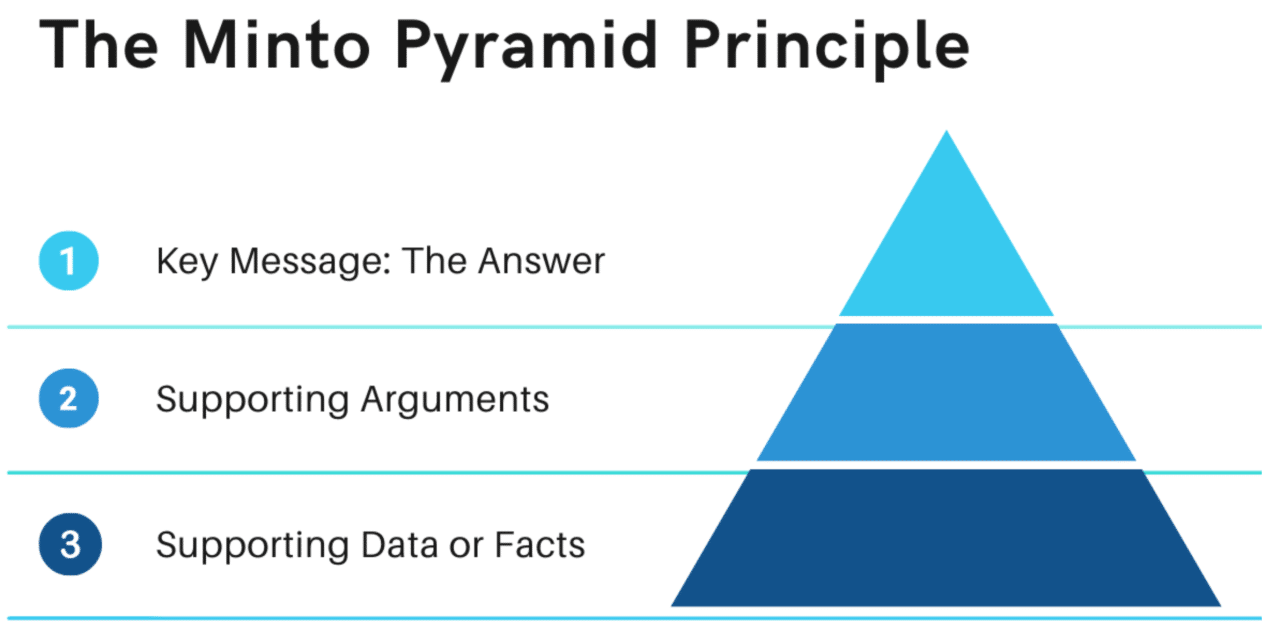The Pyramid Principle is a timeless framework that has guided leaders to achieve clarity and impact in their communication. Originating from the mind of renowned management consultant Barbara Minto, this principle has become an invaluable tool for leaders striving to articulate their ideas with precision and influence.
Origins of the Pyramid Principle
Barbara Minto first introduced the Pyramid Principle in her seminal work, “The Pyramid Principle: Logic in Writing and Thinking,” published in 1987. Drawing inspiration from the hierarchical structure of the ancient pyramids, Minto emphasized the importance of organizing ideas in a way that mirrors the natural flow of human thought. The Pyramid Principle facilitates clarity by presenting information top-down, ensuring leaders communicate their messages logically and digestibly.
Importance to a Leader
Leaders are constantly challenged to distill complex concepts into understandable messages that resonate with their teams. The Pyramid Principle is a guiding light for leaders seeking to streamline their communication, enabling them to convey ideas succinctly while maintaining their depth and impact. Its importance lies in enhancing clarity, improving decision-making processes, and ultimately fostering a more efficient and engaged team.
Putting the Pyramid Principle into Practice
1. Start with the Main Idea:
At the pinnacle of the pyramid lies the main idea or key message. Leaders should communicate by clearly stating the primary point they want to convey. This sets the tone for the rest of the message and ensures the audience grasps the core concept from the outset.
2. Support with Subpoints:
The next layer of the pyramid consists of supporting subpoints. Each subpoint should contribute to the main idea, providing additional context and details. Leaders must prioritize information, placing the most crucial details near the top of the pyramid to maintain the audience’s focus.
3. Follow a Logical Order:
Arrange information in a logical order that aligns with the natural thought process. The Pyramid Principle discourages unnecessary detours and ensures the audience can follow the narrative effortlessly. This logical flow enhances comprehension and retention.
Real-Life Examples
1. Elon Musk’s Masterful Product Launches
Elon Musk, CEO of Tesla and SpaceX, is known for distilling complex technological advancements into simple, digestible messages. During product launches, Musk adheres to the Pyramid Principle by starting with groundbreaking innovation (main idea) and gradually unfolding supporting details (subpoints), creating a narrative that captivates enthusiasts and the general public.
2. Steve Jobs’ Iconic Keynote Addresses
The late Steve Jobs, co-founder of Apple Inc., mastered employing the Pyramid Principle in his keynote addresses. Jobs would unveil a groundbreaking product (main idea) and then meticulously showcase its features and benefits (subpoints) clearly and logically. This approach not only engaged audiences but also generated anticipation and excitement.
In the complex leadership landscape, the Pyramid Principle is indispensable for those seeking to communicate with impact and clarity. Its top-down structure aligns with the natural flow of human thought, making it a practical guide for leaders aiming to streamline their messages. By incorporating this principle into their communication strategies, leaders can navigate the challenges of conveying complex ideas with finesse, ultimately fostering a culture of understanding and productivity within their teams. As demonstrated by the success stories of leaders like Elon Musk and Steve Jobs, the Pyramid Principle is a theory and a proven methodology that empowers leaders to ascend to new heights of influence and effectiveness.




